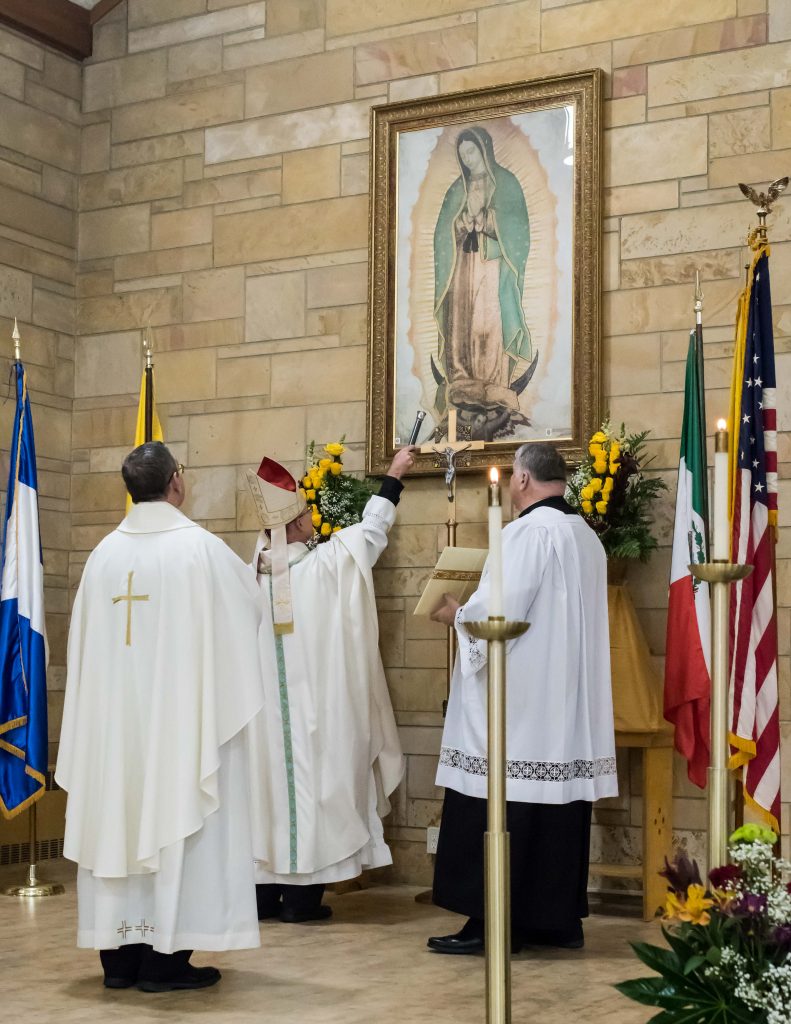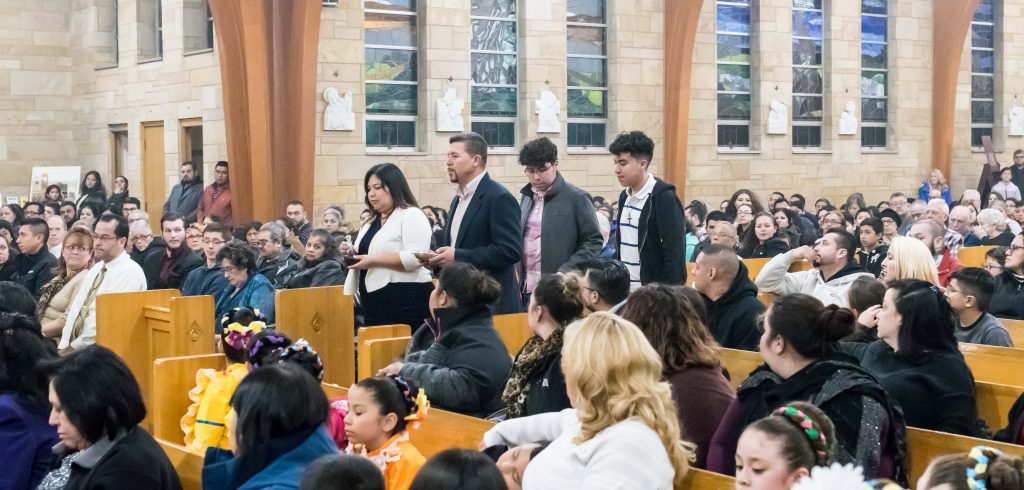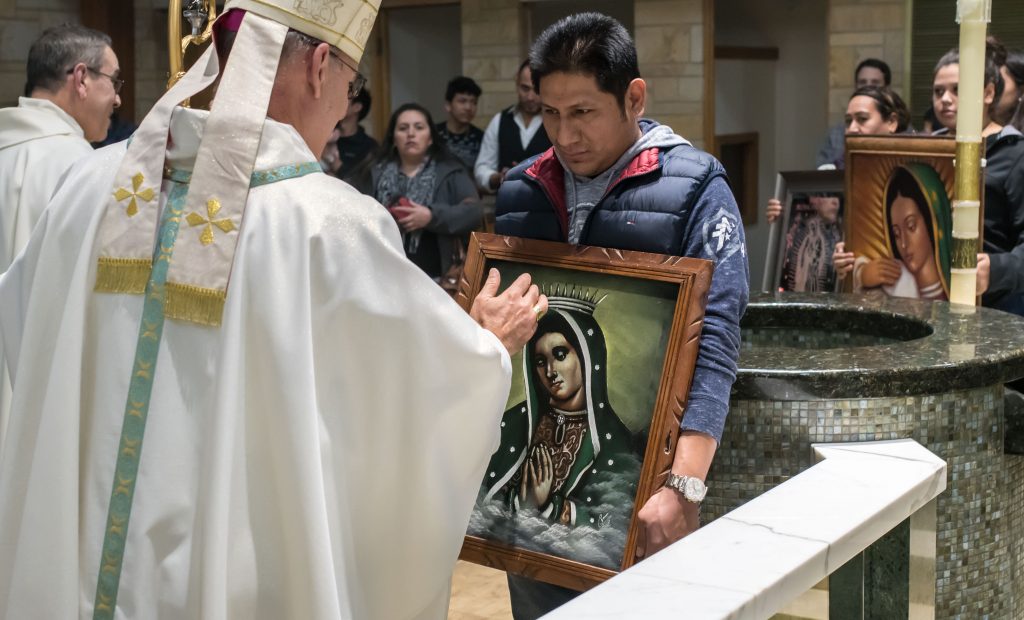December 20, 2017 // Bishop
Full house for the Patroness of All the Americas
On Tuesday night, Dec. 12, St. Joseph Parish in Fort Wayne was packed. It was so full that two pews of Franciscan friars, upon seeing the number of families standing in the back, gave up their seats for them. The friars then retrieved chairs from storage, creating row after row of makeshift pews. Even after their efforts, people still lined the walls as so many had come to celebrate a special Mass with Bishop Kevin C. Rhoades.
It was no ordinary Mass, of course, but one celebrating the feast of Our Lady of Guadalupe. A new image of Our Lady was to be blessed at the Mass by Bishop Rhoades, and as he invited the congregation to renew their devotion to the Blessed Virgin Mary, he went to the image and sprinkled holy water on it. In his homily, Bishop Rhoades briefly recounted the history of St. Juan Diego and Our Lady of Guadalupe.

After the homily on the feast of Our Lady of Guadalupe, Bishop Kevin C. Rhoades blesses and sprinkles with holy water a new image of Our Lady of Guadalupe in the sanctuary of St. Joseph Catholic Church in Fort Wayne. Photos by Joe Romie
In December 1531, an elderly Juan Diego walked to his catechism class early in the morning. Born Aztec, he had embraced Catholicism. Juan Diego was a laborer and farmer, with no education. His wife had died two years prior, and he continued to eke out a living with his uncle. He was a simple man, and very humble. It was perhaps because of these qualities that he encountered an apparition of the Virgin Mary on Tepeyac Hill, where a former Aztec temple had stood.
Mary appeared to him as a beautiful native woman and spoke his native language. She told him to visit the bishop so that a temple could be built on the site of her appearance; a temple where the people could express their sorrows and anguish, the bishop said.
Dutifully, Juan Diego went to his bishop and recounted what he had seen. The bishop, unsure of what to make of this humble farmer at first, listened politely to Juan Diego, but ultimately dismissed his claims. Back and forth Juan Diego went between Tepeyac Hill, where Mary appeared to him twice more, and the bishop. The bishop required a sign. So, Juan Diego brought him roses from the top of Tepeyac Hill in his tilma, a significant event in itself considering roses rarely bloom in December. But the roses were not what surprised the bishop: It was the image of Mary imprinted on the cloak of Juan Diego that finally convinced him that Our Lady of Guadalupe truly was acting through Juan Diego.
It is this sign, the imprinted tilma, that drew millions of pilgrims and converted so many natives. This miraculous image remains in the basilica of Our Lady of Guadalupe in Mexico City to this day.
Nearly 500 years later, Bishop Rhoades told the overflowing congregation at St. Joseph that Our Lady of Guadalupe wanted to do it again. “But this time, she wants to impress her image in our souls, in our hearts, in our lives.
“What does the Virgin Mother want from us, her children?” Bishop Rhoades continued. “The answer is simple, what every mother wants from her children: that they love God, practice their faith, keep the commandments and stop fighting. She wants us to forgive the offenses made against us and to go forward as brothers and sisters.”
As Our Lady of Guadalupe is the Patroness of all the Americas, the Mass was said in both Spanish and English before the new image of Our Lady and featuring upbeat, traditional Mexican music. St. Joseph parishioners celebrate both English and Spanish Masses on a regular basis: But to combine both languages together in this Mass was symbolic, because Our Lady of Guadalupe does not love only one America, or the United States of America, but all the Americas and all the people who live in them.
As Bishop Rhoades transitioned from speaking one language to the other, it seemed as though he spoke one united language. The parishioners, a great many of them fluent in Spanish, switched between English and Spanish as well. Exchanging signs of peace was a lingual coin-flip: Some wished peace in English, others said it in Spanish. Regardless of how they said it, everyone got a handshake or hug.
In doing this, St. Joseph parishioners were already practicing what Bishop Rhoades preached: “Just as the Virgin Mary commanded St. Juan Diego with a mission, so she does the same with her children today. She gives us the mission of sharing our Catholic faith, our love for Jesus and our Marian spirituality.” No language barrier, if there was one at all, could stop the parishioners from doing this.
The image of the Patroness of all the Americas hangs, on the wall of St. Joseph Parish as a model after which our hearts, souls and lives should follow.
The best news. Delivered to your inbox.
Subscribe to our mailing list today.








